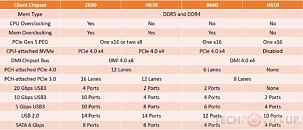- Joined
- Oct 9, 2007
- Messages
- 47,200 (7.56/day)
- Location
- Hyderabad, India
| System Name | RBMK-1000 |
|---|---|
| Processor | AMD Ryzen 7 5700G |
| Motherboard | ASUS ROG Strix B450-E Gaming |
| Cooling | DeepCool Gammax L240 V2 |
| Memory | 2x 8GB G.Skill Sniper X |
| Video Card(s) | Palit GeForce RTX 2080 SUPER GameRock |
| Storage | Western Digital Black NVMe 512GB |
| Display(s) | BenQ 1440p 60 Hz 27-inch |
| Case | Corsair Carbide 100R |
| Audio Device(s) | ASUS SupremeFX S1220A |
| Power Supply | Cooler Master MWE Gold 650W |
| Mouse | ASUS ROG Strix Impact |
| Keyboard | Gamdias Hermes E2 |
| Software | Windows 11 Pro |
Intel is preparing to significantly expand its 12th Gen Core "Alder Lake" desktop processor series next January, alongside more motherboard chipset choices for the client-desktop segment. These include the H670, the B660, and the H610. The H670 offers most of the I/O features of the top Z690 chipset, but you lose out on CPU overclocking. The B660 is the mid-tier option, and while you still get a formidable I/O feature-set, the chipset bus is narrower. The H610 is the entry-level chipset with very basic I/O, and no CPU-attached NVMe slots. The interesting thing is that all these chipsets support PCI-Express 5.0 x16 (PEG) from the CPU, but leave it to the motherboard vendors whether they want to implement it. There do exist Z690 motherboard that lack Gen 5 PEG (and only feature Gen 4).
The chipset-attached downstream PCIe also varies greatly across the lineup. The top Z690 part puts out 12 Gen 4 lanes besides 16 Gen 3 lanes; while the H670 puts out 12 each of Gen 4 and Gen 3. The B660 puts out 6 Gen 4 lanes and 8 Gen 3 lanes. The H610 completely lacks downstream Gen 4, and only puts out 8 Gen 3 lanes. The H670 and B660 put out up to two 20 Gbps USB 3.2 Gen 2x2 ports; while the H610 lacks 20 Gbps ports. All chipset models put out at least two 10 Gbps Gen 2x1 ports; and at least four 5 Gbps Gen 1x1 ports. An interesting aspect of the lineup is that Intel is allowing memory overclocking across H670 and B660 chipsets, provided the CPU supports it.

View at TechPowerUp Main Site
The chipset-attached downstream PCIe also varies greatly across the lineup. The top Z690 part puts out 12 Gen 4 lanes besides 16 Gen 3 lanes; while the H670 puts out 12 each of Gen 4 and Gen 3. The B660 puts out 6 Gen 4 lanes and 8 Gen 3 lanes. The H610 completely lacks downstream Gen 4, and only puts out 8 Gen 3 lanes. The H670 and B660 put out up to two 20 Gbps USB 3.2 Gen 2x2 ports; while the H610 lacks 20 Gbps ports. All chipset models put out at least two 10 Gbps Gen 2x1 ports; and at least four 5 Gbps Gen 1x1 ports. An interesting aspect of the lineup is that Intel is allowing memory overclocking across H670 and B660 chipsets, provided the CPU supports it.

View at TechPowerUp Main Site







